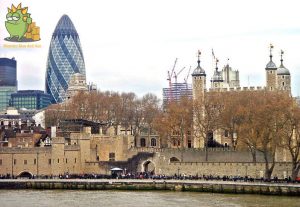The English capital is home to some of the most beautiful and majestic buildings in the world. Some of these structures were built centuries ago while others are modern edifices that display the immense technological and architectural advancement of humankind. Regardless of their age, these marvellous buildings have become internationally renowned landmarks that pull people from all four corners of the globe towards the British capital.
Buckingham Palace
The official residence of the British Royal Family is arguably the most famous structure in London and the United Kingdom. The edifice lies in the City of Westminster and dates back to the early 18th century when it was built as townhouse for the Duke of Buckingham. The building was subjected to several enlargement projects during the years and become the royal palace during the reign of Queen Victoria. The structure’s staterooms are open to the public for most of August and September, while they can be visited during some selected days in winter and spring.
The Gherkin
 Officially known as 30 St. Mary Axe, the Gherkin is one of London’s most recognisable edifices. Built from 2001 to 2003, and designed by the prominent British architectural firm, Foster and Partners, this magnificent building is one of the tallest in the city with a height of 591 feet. It comprises of 41 storeys and has a floor area of 516.100 square free. The structure is regarded as one of the best example of modern architecture in the world and has numerous reputable tenants, such as:
Officially known as 30 St. Mary Axe, the Gherkin is one of London’s most recognisable edifices. Built from 2001 to 2003, and designed by the prominent British architectural firm, Foster and Partners, this magnificent building is one of the tallest in the city with a height of 591 feet. It comprises of 41 storeys and has a floor area of 516.100 square free. The structure is regarded as one of the best example of modern architecture in the world and has numerous reputable tenants, such as:
- Standard Life
- IWG plc (formerly known as Regus)
- Hunton and Williams
- Kirkland and Ellis
- Swiss Re
- Lab 49
- ION Trading
Snaresbrook Crown Court
This historic edifice is situated in the district of Snaresbrook, which is one of the finest areas in London. This is proven by the fact that numerous people are relocating to the neighbourhood by using the punctual man and van services in Snaresbrook of Monster Man and Van. They delegate their moves to professional contractors because they know that their belongings would be brought to them in a safe and timely manner. The building is one of the twelve Crown Courts that serve Greater London and sits in a parkland that spans over 18 acres of land. The structure has twenty courtrooms that manage an estimate of 7.000 cases annually. Designed by Sir George Gilbert Scoot and William Bonython Moffatt, the edifice was constructed during the mid-19th century.
Palace of Westminster
The meeting place of the House of Commons and the House of Lords is one of the most fascinating buildings in London. It is recognised as a World Heritage Site by UNESCO and is the second incarnation of the edifice, as the original palace was destroyed by fire in 1834. The current version of the edifice was designed by Charles Barry in the Perpendicular Gothic Revival architectural style. The structure is identified by the local authorities as a Grade I building and is adjacent to the city’s most emblematic landmark, Elizabeth Tower more commonly known as Big Ben.
